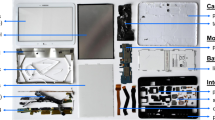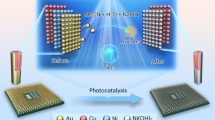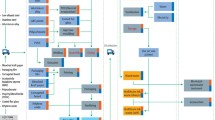Abstract
Waste electronics are a growing environmental concern but also contain materials of great economic value. If properly recycled, waste electronics could enhance the sustainability of vital metal supply chains by offsetting the increasing demand for virgin mining. However, rapid changes in the size and composition of electronics complicate their end-of-life management. Here we couple material flow and geospatial analyses on over 90 critical consumer electronic products and find that over 1 billion devices, representing up to 1.5 million tonnes of mass, could be discarded annually in the United States by 2033. Emerging electronics such as connected home, health and augmented/virtual reality devices have become the fastest-growing types in the waste stream. We highlight policy opportunities to develop various sustainable circularity strategies around metal supply chains by showing the potential to integrate waste electronics and virgin mining pathways in western US regions, while new infrastructure designed specifically for waste electronics treatment is favourable in the central and eastern United States. Furthermore, we show the importance of building national-level refining and tear-down databases to improve electronics end-of-life management in the next decade.
This is a preview of subscription content, access via your institution
Access options
Access Nature and 54 other Nature Portfolio journals
Get Nature+, our best-value online-access subscription
$29.99 / 30 days
cancel any time
Subscribe to this journal
Receive 12 digital issues and online access to articles
$119.00 per year
only $9.92 per issue
Buy this article
- Purchase on Springer Link
- Instant access to full article PDF
Prices may be subject to local taxes which are calculated during checkout





Similar content being viewed by others
Data availability
The data that support the findings of this study are available within the paper and its Supplementary Information. The supplementary dataset is available at https://github.com/ppeng-cloud/Consumer-Electronics-Recycling-Potential-in-United-States.
Code availability
All steps used in this analysis are illustrated in the Methods and Supplementary Notes 1–6. Supplementary scripts are available at https://github.com/ppeng-cloud/Consumer-Electronics-Recycling-Potential-in-United-States and from the corresponding author on reasonable request.
References
Robinson, B. H. E-waste: an assessment of global production and environmental impacts. Sci. Total Environ. 408, 183–191 (2009).
Fiore, S., Ibanescu, D., Teodosiu, C. & Ronco, A. Improving waste electric and electronic equipment management at full-scale by using material flow analysis and life cycle assessment. Sci. Total Environ. 659, 928–939 (2019).
Forti, V., Balde, C. P., Kuehr, R. & Bel, G. The Global E-waste Monitor 2020: Quantities, Flows and the Circular Economy Potential (United Nations University, 2020).
Advancing Sustainable Materials Management: 2014 Fact Sheet (USEPA, 2016).
Awasthi, A. K., Li, J., Koh, L. & Ogunseitan, O. A. Circular economy and electronic waste. Nat. Electron. 2, 86–89 (2019).
Zabala, A. Illegal electronic waste recycling trends. Nat. Sustain. 2, 353–354 (2019).
Hsu, E., Barmak, K., West, A. C. & Park, A.-H. A. Advancements in the treatment and processing of electronic waste with sustainability: a review of metal extraction and recovery technologies. Green Chem. 21, 919–936 (2019).
Nithya, R., Sivasankari, C. & Thirunavukkarasu, A. Electronic waste generation, regulation and metal recovery: a review. Environ. Chem. Lett. 19, 1347–1368 (2021).
Sun, R. et al. Bioaccumulation of short chain chlorinated paraffins in a typical freshwater food web contaminated by e-waste in South China: bioaccumulation factors, tissue distribution, and trophic transfer. Environ. Pollut. 222, 165–174 (2017).
Kyere, V. N. et al. Contamination and health risk assessment of exposure to heavy metals in soils from informal e-waste recycling site in Ghana. Emerg. Sci. J. 2, 428–436 (2018).
Purushothaman, M., Inamdar, M. G. & Muthunarayanan, V. Socio-economic impact of the e-waste pollution in India. Mater. Today Proc. 37, 280–283 (2021).
Palmieri, R., Bonifazi, G. & Serranti, S. Recycling-oriented characterization of plastic frames and printed circuit boards from mobile phones by electronic and chemical imaging. Waste Manage. (Oxf.) 34, 2120–2130 (2014).
Ghodrat, M., Rhamdhani, M. A., Brooks, G., Masood, S. & Corder, G. Techno economic analysis of electronic waste processing through black copper smelting route. J. Clean. Prod. 126, 178–190 (2016).
Diaz, L. A. & Lister, T. E. Economic evaluation of an electrochemical process for the recovery of metals from electronic waste. Waste Manage. (Oxf.) 74, 384–392 (2018).
Patil, T. A. & Patil, S. T. Techno-economic feasibility of recycling e-waste to recover precious metals. Int. J. Adv. Sci. Tech. Res 7, 214–225 (2015).
Islam, M. T. & Huda, N. Material flow analysis (MFA) as a strategic tool in e-waste management: applications, trends and future directions. J. Environ. Manage. 244, 344–361 (2019).
De Meester, S., Nachtergaele, P., Debaveye, S., Vos, P. & Dewulf, J. Using material flow analysis and life cycle assessment in decision support: a case study on WEEE valorization in Belgium. Resour. Conserv. Recycl. 142, 1–9 (2019).
Islam, M. T. & Huda, N. E-waste in Australia: generation estimation and untapped material recovery and revenue potential. J. Clean. Prod. 237, 117787 (2019).
Electronic Products Generation and Recycling in the United States, 2013 and 2014, Office of Resource Conservation and Recovery (USEPA, 2016).
Duan, H., Miller, T. R., Gregory, J., Kirchain, R. & Linnell, J. Quantitative Characterization of Domestic and Transboundary Flows of Used Electronics: Analysis of Generation, Collection, and Export in the United States (the StEP Initiative, 2013).
Althaf, S., Babbitt, C. W. & Chen, R. The evolution of consumer electronic waste in the United States. J. Ind. Ecol. 25, 693–706 (2021).
Duman, G. M., Kongar, E. & Gupta, S. M. Estimation of electronic waste using optimized multivariate grey models. Waste Manage. (Oxf.) 95, 241–249 (2019).
Golev, A., Corder, G. D. & Rhamdhani, M. A. Estimating flows and metal recovery values of waste printed circuit boards in Australian e-waste. Miner. Eng. 137, 171–176 (2019).
Golev, A., Schmeda-Lopez, D. R., Smart, S. K., Corder, G. D. & McFarland, E. W. Where next on e-waste in Australia? Waste Manage. (Oxf.) 58, 348–358 (2016).
Babbitt, C. W., Madaka, H., Althaf, S., Kasulaitis, B. & Ryen, E. G. Disassembly-based bill of materials data for consumer electronic products. Sci. Data 7, 251 (2020).
Historical Population Change Data (1910–2020) (US Census Bureau, accessed 1 July 2021); https://www.census.gov/data/tables/time-series/dec/popchange-data-text.html
2020 RECS Survey Data (US Energy Information Administration, accessed 4 July 2022); https://www.eia.gov/consumption/residential/data/2020/
2018 CBECS Survey Data (US Energy Information Administration, accessed 1 July 2022); https://www.eia.gov/consumption/commercial/data/2018/index.php?view=microdata
Ghimire, H. & Ariya, P. A. E-wastes: bridging the knowledge gaps in global production budgets, composition, recycling and sustainability implications. Sustain. Chem. 1, 154–182 (2020).
Tabelin, C. B. et al. Copper and critical metals production from porphyry ores and e-wastes: a review of resource availability, processing/recycling challenges, socio-environmental aspects, and sustainability issues. Resour. Conserv. Recycl. 170, 105610 (2021).
Peng, P. & Park, A.-H. A. Supercritical CO2-induced alteration of a polymer–metal matrix and selective extraction of valuable metals from waste printed circuit boards. Green Chem. 22, 7080–7092 (2020).
Kaya, M. Recovery of metals and nonmetals from electronic waste by physical and chemical recycling processes. Waste Manage. (Oxf.) 57, 64–90 (2016).
Wang, H. et al. Recovery of waste printed circuit boards through pyrometallurgical processing: a review. Resour. Conserv. Recycl. 126, 209–218 (2017).
Certified Electronics Recyclers (United States Environmental Protection Agency, accessed 24 February 2020); https://www.epa.gov/smm-electronics/certified-electronics-recyclers
Minerals Yearbook—Gold (USGS, 2021).
Priya, A. & Hait, S. Comprehensive characterization of printed circuit boards of various end-of-life electrical and electronic equipment for beneficiation investigation. Waste Manage. (Oxf.) 75, 103–123 (2018).
Chen, Y. et al. Selective recovery of precious metals through photocatalysis. Nat. Sustain. 4, 618–626 (2021).
Uekert, T., Pichler, C. M., Schubert, T. & Reisner, E. Solar-driven reforming of solid waste for a sustainable future. Nat. Sustain. 4, 383–391 (2021).
Işıldar, A., Rene, E. R., van Hullebusch, E. D. & Lens, P. N. L. Electronic waste as a secondary source of critical metals: management and recovery technologies. Resour. Conserv. Recycl. 135, 296–312 (2018).
Jones, R. S. & Fleischer, M. Gold in Minerals and the Composition of Native Gold 2330–5703 (US Department of the Interior, Geological Survey, 1969).
Riise, B. in Energy Technology 2020: Recycling, Carbon Dioxide Management, and Other Technologies (eds Chen, X. et al.) 295–305 (Springer Nature, 2020).
Heller, M. C., Mazor, M. H. & Keoleian, G. A. Plastics in the US: toward a material flow characterization of production, markets and end of life. Environ. Res. Lett. 15, 094034 (2020).
Chien, Y.-C., Paul Wang, H., Lin, K.-S., Huang, Y. J. & Yang, Y. W. Fate of bromine in pyrolysis of printed circuit board wastes. Chemosphere 40, 383–387 (2000).
Dushyantha, N. et al. The story of rare earth elements (REEs): occurrences, global distribution, genesis, geology, mineralogy and global production. Ore Geol. Rev. 122, 103521 (2020).
Godoy León, M. F., Matos, C. T., Georgitzikis, K., Mathieux, F. & Dewulf, J. Dewulf, J. Material system analysis: functional and nonfunctional cobalt in the EU, 2012–2016. J. Ind. Ecol. 26, 1277–1293 (2022).
January 2021 FastFacts Historical Sales Data (Consumer Technology Association, accessed 19 September 2021); https://shop.cta.tech/collections/research
Müller, E., Hilty, L. M., Widmer, R., Schluep, M. & Faulstich, M. Modeling metal stocks and flows: a review of dynamic material flow analysis methods. Environ. Sci. Technol. 48, 2102–2113 (2014).
Althaf, S., Babbitt, C. W. & Chen, R. Forecasting electronic waste flows for effective circular economy planning. Resour. Conserv. Recycl. 151, 104362 (2019).
Liu, X., Tanaka, M. & Matsui, Y. Generation amount prediction and material flow analysis of electronic waste: a case study in Beijing, China. Waste Manage. Res. 24, 434–445 (2006).
Gu, Y., Wu, Y., Xu, M., Mu, X. & Zuo, T. Waste electrical and electronic equipment (WEEE) recycling for a sustainable resource supply in the electronics industry in China. J. Clean. Prod. 127, 331–338 (2016).
Forti, V., Baldé, K. & Kuehr, R. E-waste Statistics: Guidelines on Classifications, Reporting and Indicators (United Nations Univ., 2018).
Harmonized System (HS) Codes (International Trade Administration, accessed 6 July 2021); https://www.trade.gov/harmonized-system-hs-codes#:~:text=The%20United%20States%20uses%20a,Census%20Bureau%27s%20Foreign%20Trade%20Division
Data (US Census Bureau, accessed 31 January 2021); https://www.census.gov/data.html
Active Mines and Mineral Processing Plants in the United States in 2003 (US Geological Survey, 2005).
Custom Data Package (Mining Data Online, accessed 24 February 2021); https://miningdataonline.com/property/list.aspx?vw=3
Sheaffer, K. N. Gold Data Sheet—Mineral Commodity Summaries 2020, 70–71 (USGS, 2020).
Find an R2 Certified Facility (Sustainable Electronics Recycling International, accessed 1 April 2021); https://sustainableelectronics.org/find-an-r2-certified-facility/
Smelter and Refiner List (Apple Inc., accessed 3 January 2021); https://www.apple.com/supplier-responsibility/pdf/Apple-Smelter-and-Refiner-List.pdf
List of the Smelters or Refiners Identified in Konica Minolta’s Supply Chain Which Were Known by RMI (as of March 31, 2020) (Konica Minolta, accessed 3 January 2021); https://www.konicaminolta.com/about/csr/csr/suppliers/pdf/smelters.pdf
Kasper, A. C. & Veit, H. M. Gold recovery from printed circuit boards of mobile phones scraps using a leaching solution alternative to cyanide. Braz. J. Chem. Eng. 35, 931–942 (2018).
Acknowledgements
Lawrence Berkeley National Laboratory is supported by the Office of Science of the United States Department of Energy and operated under contract grant no. DE-AC02-05CH11231. P.P. and A.S. acknowledge the Advanced Manufacturing Office of the Department of Energy for funding this research.
Author information
Authors and Affiliations
Contributions
A.S. conceptualized the study, acquired the funding and supervised the project. P.P. wrote the original draft of the paper. P.P. and A.S. developed the methodology, conducted the investigation, provided the resources, curated the data, reviewed and edited the paper and visualized the results.
Corresponding author
Ethics declarations
Competing interests
The authors declare no competing interests.
Peer review
Peer review information
Nature Sustainability thanks Shahana Althaf and the other, anonymous, reviewer(s) for their contribution to the peer review of this work.
Additional information
Publisher’s note Springer Nature remains neutral with regard to jurisdictional claims in published maps and institutional affiliations.
Supplementary information
Supplementary Information
Supplementary Notes 1–6, Figs. S1 and S2 and Tables S1–5.
Rights and permissions
About this article
Cite this article
Peng, P., Shehabi, A. Regional economic potential for recycling consumer waste electronics in the United States. Nat Sustain 6, 93–102 (2023). https://doi.org/10.1038/s41893-022-00983-9
Received:
Accepted:
Published:
Issue Date:
DOI: https://doi.org/10.1038/s41893-022-00983-9
This article is cited by
-
New pathways for e-waste recycling
Nature Sustainability (2022)
-
A fortune in gold is buried in electronic waste
Nature (2022)



